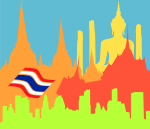- Dvaravati
-
- See Dvaraka for the Yadava capital of the Mahabharata.
 Mon Wheel of the Law (Dharmacakra), art of Dvaravati period, c. 8th century.
Mon Wheel of the Law (Dharmacakra), art of Dvaravati period, c. 8th century.
History of Thailand 
Prehistory Early history Legendary
Suvarnabhumi
Central Thailand
Dvaravati
Lavo
Supannabhum
Northern Thailand
Singhanavati
Ngoenyang
Hariphunchai
Southern Thailand
Pan Pan
Raktamaritika
Langkasuka
Srivijaya
Tambralinga
Nakhon Si ThammaratHistory Lavo Kingdom
Sukhothai Kingdom
Ayutthaya Kingdom
Thonburi Kingdom
Rattanakosin Kingdom
History since 1932 to 1973
History since 1973Regional historyRelated topicsRecent history2005-2006 Political crisis
2006 Coup d'étatThe Dvaravati (Thai: ทวารวดี) period lasted from the 6th to the 13th centuries. Dvaravati refers to both a culture and a disparate conglomerate of principalities.
Contents
History
By the 10th century, Dvaravati began to come under the influence of the Khmer Empire and central Thailand was ultimately invaded by the Khmer king Suryavarman II in the first half of the 12th century.[1] Haripunchai survived its southern progenitors until the late 13th century AD. when it was incorporated in the Lanna Kingdom.[2] The people of the region used the ancient Mon language, but whether they were ethnically Mon is unknown. There is evidence that these principalities may comprise many cultural groups of people, including Malays and Khmers. The theory of Thai migration into Dvaravati has been refuted and is now known to have happened much later.
The term Dvaravati derives from coins which were inscribed in Sanskrit with śrī dvāravatī. The Sanskrit word dvāravatī means "she with many gates " (from dvar "door gate"). Its name may derive from the mythical city of Dvāraka in ancient India.
Little is known about the administration of Dvaravati. It might simply have been a loose gathering of principalities rather than a centralised state, expanding from the coastal area of the upper peninsula to the riverine region of Chao Phraya river. Hinduism and Buddhism were significant. The main settlements appear to have been at Nakhon Pathom, U Thong and Khu Bua west of the Chao Phraya. Other towns like Lavo (modern-day Lopburi) or Si Thep were also clearly influenced by the Dvaravati culture, but probably were not part of the Dvaravati state.
Art
Dvaravati itself was heavily influenced by Indian culture, and played an important role in introducing Buddhism and particularly Buddhist art to the region.
References
- ^ "The Mon-Dvaravati Tradition of Early North-Central Thailand". The Metropolitan Museum of Art. http://www.metmuseum.org/toah/hd/mond/hd_mond.htm. Retrieved 2009-12-15.
- ^ David K. Wyatt and Aroonrut Wichienkeeo. The Chiang Mai Chronicle, p.33
Further reading
- Saraya, Dhida. (Sri) Dvaravati, Bangkok: Muang Boran, 1999, ISBN 974-7381-34-6
- Swearer, Donald K. and Sommai Premchit. The Legend of Queen Cama: Bodhiramsi's Camadevivamsa, a Translation and Commentary. New York: State University of New York Press, 1998. ISBN 079-1437-76-0
- สุรพล ดำริห์กุล, ประวัติศาสตร์และศิลปะหริภุญไชย, กรุงเทพฯ: สำนักพิมพ์เมืองโบราณ, 2004, ISBN 974-7383-61-6
External links
 Media related to Dvaravati at Wikimedia Commons
Media related to Dvaravati at Wikimedia CommonsThis Southeast Asian history-related article is a stub. You can help Wikipedia by expanding it.


